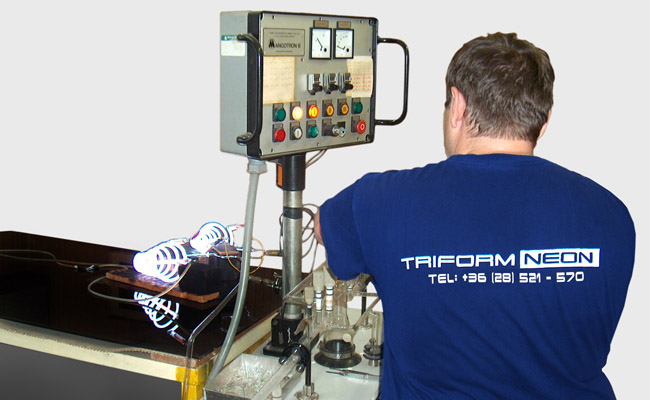Things to know about the Neon
The high-voltage neon tubes were begun to be used from the 1920s, and although they are not as popular today, as they were in the ’80s and ’90s, it has begun to get its old ’shine’ back. We are talking about a stabile system, with a prominent and decorative appearance.
The size of the neon tube is 8-20mm (in extreme cases a thicker glass tube is used, but its heating is not so simple) in diameter, 1mm in depth, glass tube (in an exceptional case it can be 6mm in diameter). At both ends of the neon tube one can find 1-1 soldered electrodes. The glass tube could be bent into any desired shape, even to an outline of an inscription, but it is widely used to illuminate the contours of a building. The neon tube is filled with gas or gas-mixture of the needed colour, at neon tubes light-powder is frequently used to get the desired colour. Due to the high-voltage every gas lights in its characteristical colour. (Neon gas in res, blueish-purpleish the mixture of mercury and argon steam, etc.).
The filling of the gas should be understood non-literally: first, the air in the tube is removed with a vacuum-pump, and then it is ’filled’ with the gas equal to the 1/100th of the atmospheric pressure. The industrial current flowing through the neon tubes is typically between 60 and 100 mA.
Its life-span is principally infinite, because it does not contain filaments. Only outside circumstances can worsen its life-span, a hit, a hair-crack can lead to the escape of the gas.

Some interesting facts:
The ancestor of the neon tube is the lightning. An electric discharge which amazed even the prehistoric man. The scientists of the 18th century created giant sparks with their rub-electric machines in their laboratories; this is how they modelled the lightning. In the 1850s the glass-blower master Heinrich Geissler made an excellent air vacuum-pump, and solved the vacuum-closed soldering of the electrodes into the glass tube. These tubes could be used anywhere, and anytime without the air vacuum-pump. The glass-blower masters, who were the artists of the glass too, could give various forms of the Geissler-tubes.
At the end of the 19th century Moore made tubes filled with carbon-dioxide and nitrogen. Although the light of the tubes was weak, installing them around the ceiling of a room, they could be used for lighting. In spite of the fact that their operation was slow and complicated, they were in use in the 1900s in lighting bodies. The invention of noble gases gave a new direction to the manufacturing of the light tubes. This is connected mainly to the French scientist Claude and the German scientist Linde, who experimented successfully with the cheaper producing of the noble gases. Claude introduced the first light tube filled with neon gas with gas-discharging at the 1910 car-exhibition in Paris, which was shortly followed by the first neon advertisement above a Parisian hair-saloon with the sing ’Carravalio’.